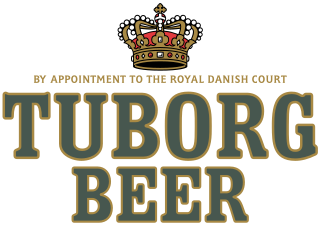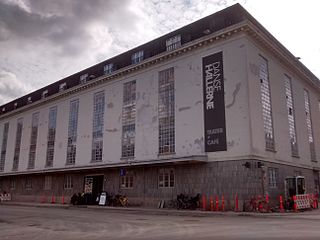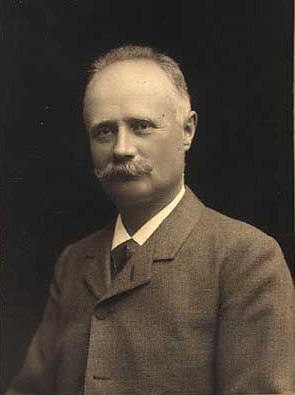
Jacob Christian Jacobsen, mostly known as J. C. Jacobsen, was a Danish industrialist and philanthropist best known for founding the brewery Carlsberg.

The Ny Carlsberg Glyptotek, commonly known simply as Glyptoteket, is an art museum in Copenhagen, Denmark. The collection represents the private art collection of Carl Jacobsen (1842–1914), the son of the founder of the Carlsberg Breweries.

Carlsberg A/S is a Danish multinational brewer. Founded in 1847 by J. C. Jacobsen, the company's headquarters is in Copenhagen, Denmark. Since Jacobsen's death in 1887, the majority owner of the company has been the Carlsberg Foundation. The company's flagship brand is Carlsberg. Other brands include Tuborg, Kronenbourg, Somersby cider, Holsten, Neptun, Russia's best-selling beer Baltika, Belgian Grimbergen, Fix, one of Greece's oldest brands and more than 500 local beers. The company employs around 41,000 people, primarily in Western Europe, Russia and Asia.

Carl Christian Hillman Jacobsen was a Danish brewer, art collector and philanthropist. Though often preoccupied with his cultural interests, Jacobsen was a shrewd and visionary businessman and initiated the transition of the brewery Carlsberg from a local Copenhagen brewery to the multinational conglomerate that it is today.

Tuborg is a Danish brewing company founded in 1873 on a harbour in Hellerup, an area North of Copenhagen, Denmark. Since 1970 it has been part of the Carlsberg Group. The brewery's flagship, the Tuborg pilsner, was brewed for the first time in 1880.

Frederiksborg Castle is a palatial complex in Hillerød, Denmark. It was built as a royal residence for King Christian IV of Denmark-Norway in the early 17th century, replacing an older castle acquired by Frederick II and becoming the largest Renaissance residence in Scandinavia. On three islets in the Slotssøen, it is adjoined by a large formal garden in the Baroque style.

The beer market in Denmark is dominated by the brands Carlsberg and Tuborg. Since Tuborg was acquired by Carlsberg in 1970, Carlsberg has held a near-monopoly. A number of regional breweries, however, managed to survive, and most of them merged into Royal Unibrew in 2005. As of 2020, Ratebeer lists over 300 active breweries in Denmark, most of which are microbreweries.

Valby is one of the 10 official districts of Copenhagen, Denmark. It is in the southwestern corner of Copenhagen Municipality, and has a mixture of different types of housing. This includes apartment blocks, terraced housing, areas with single-family houses and allotments, plus the remaining part of the old Valby village, around which the district has formed, intermingled with past and present industrial sites.

The Carlsberg Research Laboratory is a private scientific research center in Copenhagen, Denmark under the Carlsberg Group. It was founded in 1875 by J. C. Jacobsen, the founder of the Carlsberg brewery, with the purpose of advancing biochemical knowledge, especially relating to brewing. It featured a Department of Chemistry and a Department of Physiology. In 1972, the laboratory was renamed the Carlsberg Research Center and was transferred to the brewery.

Hellerup is a very affluent district of Gentofte Municipality in the suburbs of Copenhagen, Denmark. The most urban part of the district is centred on Strandvejen and is bordered by Østerbro to the south and the Øresund to the east. It comprises Tuborg Havn, the redeveloped brewery site of Tuborg Breweries, with the Waterfront Shopping Center, a marina and the headquarters of several large companies. Other parts of the district consist of single family detached homes. Local landmarks include the science centre Experimentarium and the art Øregaard Museum.

Carlsberg is an area located straddling the border of Valby and Vesterbro districts in central Copenhagen, Denmark approximately 2.4 km from the City Hall Square. The area emerged when J.C. Jacobsen founded his original brewery in the district in 1847. The first brewing took place on 11 November 1847 and production continued until 30 October 2008, when production was moved to Fredericia in Jutland. The Jacobsen House Brewery is however still located in the district and produces specialty beers. The entire brewery grounds spread over more than 30 hectares and is currently being transformed into a new city district in Copenhagen.

The Jesus Church is a church situated just off Valby Langgade in the Valby district of Copenhagen, Denmark. It was commissioned by second-generation Carlsberg brewer Carl Jacobsen and designed by Vilhelm Dahlerup. Noted for its extensive ornamentation and artwork, it is considered to be one of the country's most idiosyncratic and unconventional examples of church architecture. The church was built as a mausoleum for Carl Jacobsen and his family and is located close to their former house as well as the former Carlsberg brewery site. Their sarcophagi lie in the crypt. Throughout the church, there are ornaments and inscriptions associated with the family.

Carlsberg Lighthouse, also known as the Lime Tower after the limestone which is its dominating building material, is a former lighthouse located in the Carlsberg area of Copenhagen, Denmark.

Tap E is a former storage building of a bottling plant in the Vesterbro district of Copenhagen, Denmark, part of Carlsberg's historic brewery site which is now known simply as the Carlsberg area. After the production of beer in the area stopped in 2009, the listed building has been taken unto use as a cultural venue which houses both a centre for modern dance, Dansehallerne, and Fotografisk Center, a gallery and digital laboratory dedicated to fine art photography.

The Grey House is a listed building in the Carlsberg area of Copenhagen, Denmark.

Carlsberg Museum, situated next to the former home of Carl Jacobsen in the Carlsberg area of Copenhagen, Denmark, was the first home of his sculpture collection, now on display in the Ny Carlsberg Glyptotek in the city centre. The building consists of a total of 20 galleries accumulated between 1892 and 1895 through a series of extensions to designs by Vilhelm Dahlerup and Hack Kampmann. It now serves as a venue for conferences, receptions and other events.

Hotel Ottilia is a 155-room boutique hotel operated by Brøchner Hotels in two former brewery buildings in the Carlsberg area of Copenhagen, Denmark. The older building, known as the Malt Chamber, is from 1881 and was designed by Vilhelm Dahlerup. The other one, Storage Cellar 3, was built to a Functionalist design in 1969. Both buildings are listed in the Danish registry of protected buildings and places. The hotel opened in 2019. It takes its name after Ottilia Jacobsen, the wife of second generation Carlsberg brewer Carl Jacobsen.

Søren Anton van der Aa Kühle was a Danish brewer and chief business executive. He was chief operational officer of Gamle Carlsberg from 1881 and succeeded J.C. Jacobsen as managing director of the brewery in 1887.

Ny Carlsberg Vej is a street in the Vesterbro district of Copenhagen, Denmark. It runs from Sønder Boulevard in the east to the point where Pile Allé turns into Valby Langgade at the southeastern corner of the park Søndermarken in the west. The last cobbled part of the street passes through the Carlsberg neighbourhood. This section of the street is spanned by the Dipylon Building and the Elephant Tower, both of which were designed by Vilhelm Dahlerup in the ornate Historicist style andare among the most iconic buildings of the former Carlsberg brewery site.

Brolæggerstræde, also known as J. C. Jacobsens Bryggergård, was the location of Carlsberg-founder J. C. Jacobsen's first breweryin Copenhagen, Denmark. He kept the property after inaugurating his new Carlsberg Brewery in Valby in 1847 and building an extravagant new home next to it in 1854. A commemorative plaque above the gate commemorates that J. C. Jacobsen's son Carl Jacobsen was born in the building in 1842 and that J. C. Jacobsen undertook his first experiments with the brewing of lager beer on the site in 1838. The property comprises a five-storey brewery building in the courtyard as well as a four-storey apartment building and a former warehouse around the corner at Knabrostræde 11–13. The entire complex was constructed as part of the rebuilding of the city following the Copenhagen Fire of 1795. It was listed in the Danish registry of protected buildings and places in 1945. The property is now owned by the Carlsberg Foundation and the Ny Carlsberg Foundation is based in the brewery building in the courtyard. Other notable former residents include the writer Thomas Christopher Bruun, composer Friedrich Ludwig Æmilius Kunzen, theologian Jens Møller and architect Johan Daniel Herholdt. The adjacent corner building Knabrostræde 9 was also listed in 1045 and is also owned by the Carlsberg Foundation. A commemorative plaque on the chamfered corner commemoraties that J. C. Jacobsen was born in the building in 1811.




















